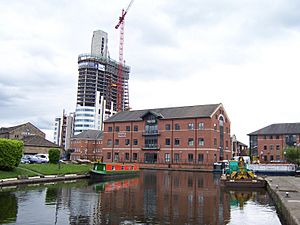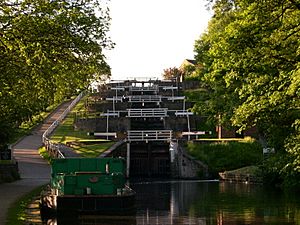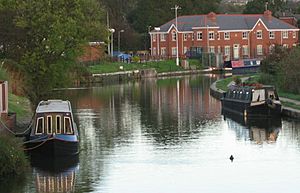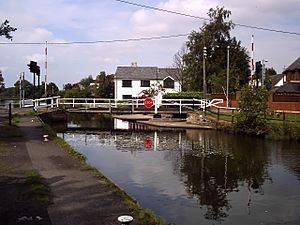Leeds and Liverpool Canal facts for kids
Quick facts for kids Leeds and Liverpool Canal |
|
|---|---|

Ainscoughs mill in Burscough
|
|
| Specifications | |
| Maximum boat length | 62 ft 0 in (18.90 m) (A 62' boat can traverse the whole canal; craft up to 72' formerly worked between Liverpool and Leigh.) |
| Maximum boat beam | 14 ft 4 in (4.37 m) (Boats with a beam of 14' 4" can traverse the whole canal; craft with a beam up to 14' 6" formerly worked between Liverpool and Leigh.) |
| Locks | 91 |
| Maximum height above sea level | 487 ft (148 m) |
| Status | Open |
| Navigation authority | Canal & River Trust |
| History | |
| Principal engineer | John Longbotham |
| Other engineer(s) | James Brindley Robert Whitworth |
| Date of act | 1770 |
| Construction began | 1770 |
| Date of first use | 1774 |
| Date completed | 1816 |
| Date extended | 1822 |
| Geography | |
| Start point | 53°47′34″N 1°32′53″W / 53.7928°N 1.5480°W |
| End point | 53°24′11″N 2°59′34″W / 53.4030°N 2.9929°W |
The Leeds and Liverpool Canal is a long canal in Northern England. It connects the big cities of Leeds and Liverpool.
This canal is about 127 miles (204 km) long. It crosses the Pennines, which are a range of hills. The main part of the canal has 91 locks. Locks are like water elevators that help boats move up and down hills. The canal also has smaller branches. In the early 2000s, a new path was built to connect it to the Liverpool docks.
Contents
History of the Canal
Why the Canal Was Built
In the mid-1700s, towns like Leeds and Bradford in Yorkshire were growing fast. They needed better ways to trade goods. While Leeds could send goods east by river, going west was hard. Merchants in Bradford wanted to bring in limestone to make lime. They also wanted to send their textiles to the busy Port of Liverpool.
On the other side, Liverpool traders needed cheap coal for their ships and factories. They also wanted to get goods from the industrial areas of Lancashire. People saw how well the Bridgewater Canal worked. This made them think a canal across the Pennines would be a great idea. It would link Liverpool to Hull through other waterways.
In 1766, a meeting was held in Bradford to plan the canal. John Longbotham was hired to map out a route. But people in Liverpool didn't like his first idea. They thought it missed important towns and coal fields. Other engineers suggested different routes. Finally, James Brindley helped decide on a route. He chose a path similar to Longbotham's, but with a branch to Wigan. In 1768, Brindley estimated the canal would be about 109 miles (175 km) long. He thought it would cost around £259,777.
In May 1770, a law was passed to allow the canal to be built. Brindley became the chief engineer.
Building the Canal: The First Steps
Building started on 5 November 1770, near Liverpool. The first part of the canal opened in 1773, from Bingley to Skipton. By 1774, it reached Shipley. This section included amazing engineering works. These included the Bingley Five Rise Locks and the Bingley Three Rise Locks. There was also a seven-arch bridge over the River Aire. A branch to Bradford was also finished.
On the western side, the canal reached Newburgh from Liverpool. By 1775, the eastern end reached Gargrave. By 1777, the canal connected to the Aire and Calder Navigation in Leeds. From Liverpool, it reached Wigan by 1781. But by this time, all the money was spent. Work stopped in 1781. This was also because of the American Revolutionary War.
Building the Canal: The Middle Years
In 1789, Robert Whitworth suggested new plans for the canal's path. He proposed a tunnel at Foulridge. This would make the highest point of the canal lower. These new plans were approved in 1790. Building started again in 1791, moving towards Barrowford in Lancashire.
In 1794, the canal company realized that coal, not limestone, would be their main cargo. So, the route was changed again. It moved closer to the coal mines in Burnley, Accrington, and Blackburn. This new path needed some big earthworks.
The 1,640 yards (1,500 m) long Foulridge Tunnel was finished in 1796. This was a very difficult and expensive part of the project. It cost £40,000. It allowed the canal to open to eastern Burnley.
At Burnley, Whitworth designed the Burnley Embankment. This was a huge earthwork, 1,350 yards (1,234 m) long and up to 60 feet (18 m) high. It took five years to build. Whitworth died in 1799, and Samuel Fletcher took over. Once the Burnley work was done, the canal opened to Enfield in 1801. It took nine more years to reach Blackburn. Building was slow because of the Napoleonic Wars. High taxes and interest rates made it hard to borrow money.
Building the Canal: The Final Push
In 1804, Samuel Fletcher died. His brother Joseph and son James took over. They estimated the cost to link Enfield to Wigan would be £347,000.
The canal was finally completed in 1816. It connected with the Lancaster Canal between Aspull and Johnson's Hillock.
There had been talks for a long time about connecting the canal to the Bridgewater Canal at Leigh. An agreement was finally made in 1818. This connection opened in 1820. It gave the Leeds and Liverpool Canal access to Manchester and the rest of the canal network. The Leeds and Liverpool Canal was built for wide boats. But the Bridgewater Canal used narrower boats. So, the locks at the western end of the Leeds and Liverpool Canal were made longer in 1822. This allowed the narrower boats to reach Liverpool.
How the Canal Was Used
The canal took almost 50 years to build. The most important cargo was always coal. Over a million tons of coal were sent to Liverpool each year in the 1860s. The canal was built with wide locks. This helped it compete well with the new railways. It stayed open and busy throughout the 1800s and 1900s.
The Canal in the 20th Century

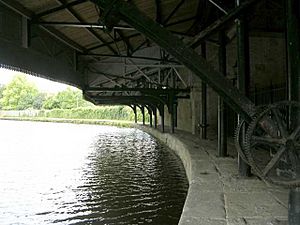
The canal was damaged a bit during World War II. A German bomb hit it in Bootle. The canal in West Lancashire was part of Britain's defenses against invasion. There were tank traps, bunkers, and blockhouses along the canal. Some buildings like barns and pubs were made stronger for defense. You can still see some concrete pillboxes and brick blockhouses today.
The Canal in the 21st Century

In August 2010, a 60-mile part of the canal had to close. This was because of low water levels after a very dry period. It reopened the next month.
The £22 million Liverpool Canal Link was finished in 2009. This new link connects the Leeds and Liverpool Canal directly to the Liverpool city centre.
The Canal's Route
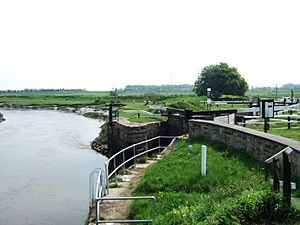
The Leeds and Liverpool Canal is 127 miles (204 km) long. It goes from Liverpool to Leeds, passing through East Lancashire and the Pennines. Its locks are usually 60 ft (18 m) long and 14 ft 3 in (4.34 m) wide.
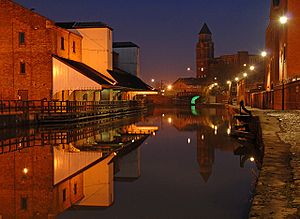
From Liverpool to Appley Locks, the canal runs for 27 miles (43 km) without any locks. This part crosses the flat West Lancashire Coastal Plain.
The canal has two main side-branches that connect to other waterways.
- The Rufford Branch connects to the River Douglas. Through the Ribble Link and the River Ribble, it links to the Lancaster Canal.
- The Leigh Branch from Wigan leads to the Bridgewater Canal. This gives access to Manchester and the Midlands.
Near Aintree, the canal passes close to the famous Aintree Racecourse. This is where the Grand National horse race takes place. The course even has a jump called "Canal Turn" named after the canal.
Places Along the Canal
Direction: East (top) to west (bottom)
- Leeds
- Granary Wharf, Leeds city centre
- Armley Pool
- Kirkstall
- Bramley
- Apperley Bridge
- Shipley
- Saltaire
- Bingley
- Keighley
- Silsden
- Skipton
- Gargrave
- Barnoldswick
- Foulridge Tunnel
- Nelson
- Brierfield
- Burnley
- Hapton
- Clayton-le-Moors
- Church
- Oswaldtwistle
- Blackburn
- Wheelton
- Chorley
- Adlington
- Leigh
- Wigan - Wigan Pier
- Appley Bridge
- Parbold
- Rufford branch:
- Rufford
- Stanley Dock Branch:
- Stanley Dock


